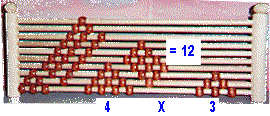


A MULTIPLICATION MATH LESSON
To teach multiplication through arithmetic counting translate arithmetic counting into an association of verse and rhythmical movement. The student takes this activity deeply into their limbs through repetition. Then a picture understanding of arithmetic counting is presented by the teacher which the students play will mature into their own working imagination of the concept.
An archetypal character such as a gnome might be used to represent the imaginative activity of the rhythmical arithmetic counting. The gnome may be turning cartwheels, with a series of turns representing an arithmetic sequence. The figure of the gnomes body would be of it's arms and legs stretched out to form an X as it turns cartwheels, so arithmetic counting will be associated with the symbol for times or multiplication. Now, the student has the rhythmical movement in their will and the picture understanding in their thinking.
At the point when students can independently recall the picture understanding presented, the
learning activity must be enhanced. For example, out of the imagination the students have been presented, the cartwheels of the gnomes may be represented as repeating arcs or hills associated with arithmetic counting.



A picture of numbers with common multiples or friendly numbers that meet to play sometimes can be given as shown above for four and six, their sequences meeting at twelve. The symbol for multiplication through the figure of the gnome is used to associate it with the arithmetic counting procedure.

The verse and painting illustrated above might be brought at this point as they begin to practice the picture thinking, they now can recall independently. The painting is an artistic transformation of the imagination. The repetition of the picture thinking process to solve problems, the recitation of the verse, and the painting of the picture will put the lesson to sleep in the student's habit life. The recitation of the verse with the painting of the picture might be repeated a time or two after the block is completed, then all must sleep deep within through the conceptual winter. Long-term cultural and educational understanding and memory depend on the transformation of imagination and relationship artistically.
To reawaken the picture thinking, the same painting may be used slightly modified as a drawing with a wake up verse.

Review the presented picture understanding of arithmetic counting and multiplication. Now it is time to encourage flexible thinking by introducing other pictures of multiplication. In the imagination above a temporal or sequential picture was presented first, so a spatial picture would be good to present next. A new gnome might be introduced, one more earthy. He stores small stones in triangular stacks to use when building. The children can use plasticene to make stones and stack them. The gnome takes stones from his stack and puts them into his cart, (as shown) when he needs them. Note that the cart design associates the multiplication symbol with the spatial configuration of the stones in it. In the example the student can be shown how the gnome stacks columns of four stones along one side of the cart, then repeats the column three times to get twelve in his cart altogether.

To reveal this geometric relationship, for other numbers, the Pythagorean Abacus
is an excellent manipulative The solution to four times three is exampled below. The rectangular array, between two triangular arrays, will always be the product of the numbers of beads at the bases of the triangles.

Exploring various approaches and modalities for solving multiplication problems will be like discovering the many colored blossoms of spring, heralding new fruit. This learning sequence leaves the seeds of understanding maturing in the thinking of each student.